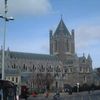

Christ Church Cathedral
 |
 |
Over the centuries the Cathedral suffered many ignomimies, not least the use being made of the vaults as taverns and the nave as a market in the late 1500s. In 1562 the nave vaulting collapsed bringing with it the south wall. The Cathedral was in such a state of disrepair by the mid 1800s that there was a real treat to its survival. Not to be outdone by Sir Benjamin Lee Guinness' magnanimous gesture in providing the money for the restoration of nearby St Patrick's Cathedral in 1864, Genry Roe, a Dublin whiskey distiller, stepped in with both the interest and the money required to save this great Cathedral. The restoration cost £ 250,000, quite a sum at that time.
Christ Church is a fine example of early-Gothic architecture and the accompanying Romanesque sections which date to the late 12th century provide an interesting opportunity to view two clearly distinct styles of architecture.
Treasures of the Cathedral displays an unique range of manuscripts, historic artefacts and spectacular examples of gold and silver ware. Of particular interest are the silver gift plate given by William 3 in thandsgiving for his victory at the Battle of the Boyne in 1690 and the restored tabernacle used in Christ Church during the return of the Roman Catholic liturgy under James 2.